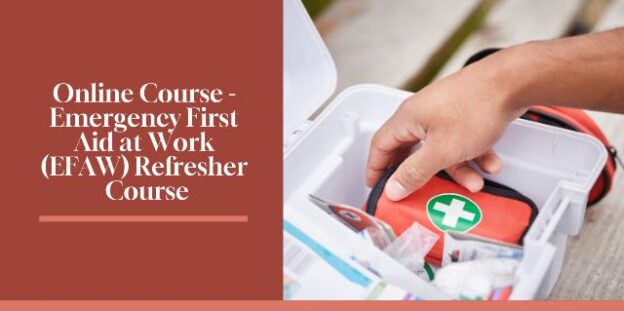The Emergency First Aid at Work (EFAW) Refresher Course is designed to provide participants with updated knowledge and skills required to respond effectively to workplace emergencies. This course serves as a refresher for individuals who have previously completed the full EFAW training and need to renew their certification. Participants will review essential first-aid techniques, refresh their understanding of emergency procedures, and enhance their confidence in handling critical situations.
What you’ll learn:
Module 1: Introduction and Course Overview
– Overview of the EFAW Refresher Course
– Importance of regular first aid training updates
– Understanding legal requirements and responsibilities
Module 2: Assessing the Situation
– Effective scene assessment and hazard identification
– Prioritizing safety and managing potential risks
– Communicating and coordinating with emergency services
Module 3: CPR and AED Refresher
– Recap of cardiopulmonary resuscitation (CPR) techniques
– Hands-only CPR and rescue breaths
– Automated External Defibrillator (AED) usage and demonstrations
Module 4: Dealing with Bleeding and Wounds
– Identifying and managing different types of bleeding
– Applying direct pressure, elevation, and dressing techniques
– Recognizing signs of severe bleeding and when to seek medical assistance
Module 5: Managing Choking and Airway Obstruction
– Review of techniques for assisting a conscious choking victim
– Procedures for relieving airway obstruction in an unconscious person
– Practicing abdominal thrusts and back blows
Module 6: Treating Shock and Unconsciousness
– Understanding the signs and symptoms of shock
– Providing first aid for shock, including positioning and reassurance
– Recovery position and care for an unconscious casualty
Module 7: Assessing and Responding to Common Injuries
– Reviewing first aid procedures for fractures, sprains, and strains
– Treating burns, scalds, and chemical exposures
– Managing eye injuries and minor injuries
Module 8: Emergency First Aid in Specific Situations
– Handling medical emergencies such as heart attacks, strokes, and seizures
– Recognizing and responding to allergic reactions and anaphylaxis
– Understanding the administration of emergency medications (e.g., EpiPen)
Module 9: First Aid Record Keeping and Reporting
– Importance of accurate first aid record keeping
– Completing incident reports and documentation
– Legal considerations and confidentiality requirements
Career Path:
The EFAW Refresher Course is essential for individuals who are required to maintain their emergency first aid skills in the workplace. While it does not lead to a specific career path, it can greatly enhance your employability and contribute to various roles where first aid skills are valued. Some potential career paths include:
1. Workplace First Aid Team Member: Serve as a designated first aider in your workplace, supporting the health and safety of employees. Provide immediate assistance during medical emergencies and be responsible for maintaining first aid supplies.
2. Health and Safety Officer: Combine your EFAW Refresher Course with broader health and safety knowledge to work as a health and safety officer in an organization. Ensure compliance with first aid regulations, conduct risk assessments, and implement safety protocols.
3. Security Officer: Enhance your skills as a security officer by incorporating emergency first aid training. Respond effectively to medical emergencies that may occur in public spaces or events.
4. Childcare Provider: Equip yourself with up-to-date first aid skills to work in childcare settings, such as daycare centres or schools. Ensure the safety and well-being of children by being prepared to respond to injuries or medical incidents.
5. Fitness Instructor/Coach: Stand out as a fitness professional by having updated first aid knowledge. Be capable of responding to potential injuries or health emergencies that may occur during training sessions or events.
6. Volunteer or Community Responder: Contribute to your community by joining volunteer organizations or becoming a community responder. Assist during local events, emergencies, or natural disasters where immediate first aid support is required.

